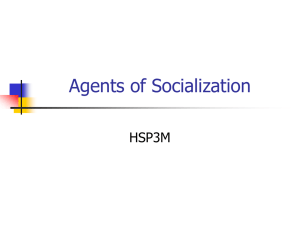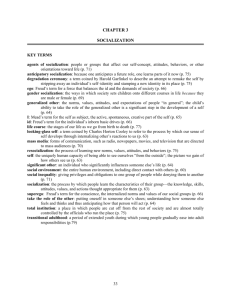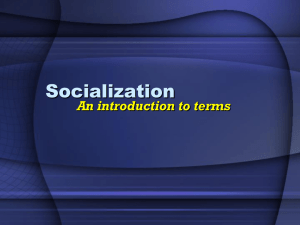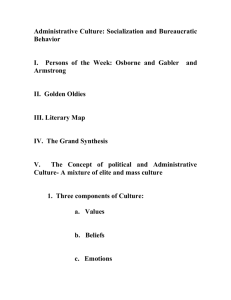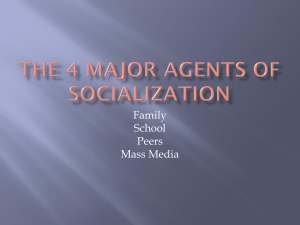chapter summary - Barrington 220
advertisement
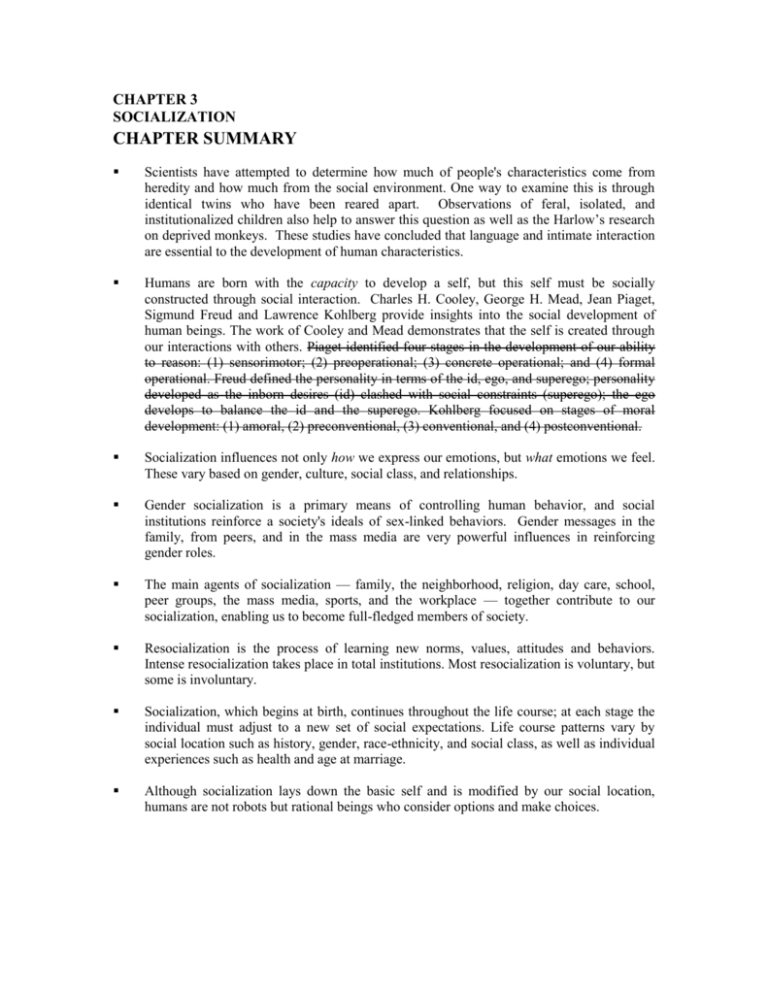
CHAPTER 3 SOCIALIZATION CHAPTER SUMMARY Scientists have attempted to determine how much of people's characteristics come from heredity and how much from the social environment. One way to examine this is through identical twins who have been reared apart. Observations of feral, isolated, and institutionalized children also help to answer this question as well as the Harlow’s research on deprived monkeys. These studies have concluded that language and intimate interaction are essential to the development of human characteristics. Humans are born with the capacity to develop a self, but this self must be socially constructed through social interaction. Charles H. Cooley, George H. Mead, Jean Piaget, Sigmund Freud and Lawrence Kohlberg provide insights into the social development of human beings. The work of Cooley and Mead demonstrates that the self is created through our interactions with others. Piaget identified four stages in the development of our ability to reason: (1) sensorimotor; (2) preoperational; (3) concrete operational; and (4) formal operational. Freud defined the personality in terms of the id, ego, and superego; personality developed as the inborn desires (id) clashed with social constraints (superego); the ego develops to balance the id and the superego. Kohlberg focused on stages of moral development: (1) amoral, (2) preconventional, (3) conventional, and (4) postconventional. Socialization influences not only how we express our emotions, but what emotions we feel. These vary based on gender, culture, social class, and relationships. Gender socialization is a primary means of controlling human behavior, and social institutions reinforce a society's ideals of sex-linked behaviors. Gender messages in the family, from peers, and in the mass media are very powerful influences in reinforcing gender roles. The main agents of socialization — family, the neighborhood, religion, day care, school, peer groups, the mass media, sports, and the workplace — together contribute to our socialization, enabling us to become full-fledged members of society. Resocialization is the process of learning new norms, values, attitudes and behaviors. Intense resocialization takes place in total institutions. Most resocialization is voluntary, but some is involuntary. Socialization, which begins at birth, continues throughout the life course; at each stage the individual must adjust to a new set of social expectations. Life course patterns vary by social location such as history, gender, race-ethnicity, and social class, as well as individual experiences such as health and age at marriage. Although socialization lays down the basic self and is modified by our social location, humans are not robots but rational beings who consider options and make choices. Chapter 3: Socialization LEARNING OBJECTIVES After reading Chapter 3, you should be able to: 1. 2. 3. 4. 5. 6. 7. 8. 9. 10. 11. 12. 13. 14. 15. 16. 17. Discuss the ongoing debate over what most determines human behavior: “nature” (heredity) or “nurture” (social environment), and cite the evidence that best supports one position or the other. (64-68) Discuss how studies of feral, isolated, and institutionalized children prove that social contact and interaction is essential for healthy human development. (64-67) Identify key findings from Margaret and Harry Harlow’s research on deprived monkeys and how this research can be extrapolated to human beings. (67-68) Explain Charles Horton Cooley’s theory on the looking glass self. (68) Discuss the stages that George Herbert Mead has identified in role taking. (69) Explain Jean Piaget’s research on the development of reasoning and identify what happens in each stage. (70) Explain Freud’s view on the development of personality and sociologist view of Freud’s theory. (72) Differentiate between Kohlberg and Gilligan’s theory on the development of morality. (7273) Talk about how socialization is not only critical to the development of the mind, but also to the development of emotions — affecting not only how people express their emotions, but also what particular emotions they may feel. (73-75) Know what is meant by gender socialization and how the family, media, and other agents of socialization teach children, from the time of their birth, to act masculine or feminine based on their gender. (75-77) Describe some of the “gender messages” in the family and mass media and discuss how these messages may contribute to social inequality between men and women. (75-78) List the major agents of socialization in American society, and talk about how each of these teach — and influence — people’s attitudes, behaviors, and other orientations toward life. (78-85) Define the term resocialization and provide examples of situations that may necessitate resocialization. (85) Discuss how different settings, including total institutions, may go about the task of resocializing individuals. (84-85) Understand why socialization is a lifelong process and summarize the needs, expectations, and responsibilities that typically accompany different stages of life. (86-90) Identify changes that have occurred within society that have impacted how stages of the life course have changed over time. (86-90) Discuss why human beings are not prisoners of socialization while providing examples of how people can — and do — exercise a considerable degree of freedom over which agents of socialization to follow and which cultural messages to accept — or not accept — from those agents of socialization. (91) KEY TERMS After studying the chapter, review the definition for each of the following terms. agents of socialization: people or groups that affect our self-concept, attitudes, or other orientations towards life (78) anticipatory socialization: because one anticipates a future role, one learns part of it now (84) degradation ceremony: a term coined by Harold Garfinkel to describe an attempt to remake the self by stripping away an individual's self-identity and stamping a new identity in its place (85) ego: Freud's term for a balancing force between the id and the demands of society (72) Sociology: A Down-to-Earth Approach feral children: children assumed to have been raised by animals, in the wilderness, isolated from other humans (65) gender role: the behaviors and attitudes considered appropriate because one is male or female (77) gender socialization: the ways in which society sets children onto different courses in life because they are male or female (75) generalized other: the norms, values, attitudes, and expectations of people "in general"; the child's ability to take the role of the generalized other is a significant step in the development of a self (68) id: Freud's term for our inborn basic drives (72) latent function: unintended beneficial consequences of people’s actions (81) life course: the stages of our life as we go from birth to death (87) looking-glass self: a term coined by Charles Horton Cooley to refer to the process by which our self develops through internalizing others' reactions to us (68) manifest function: the intended consequences of people's actions designed to help some part of the social system (81) mass media: forms of communication, such as radio, newspapers, and television, that are directed to mass audiences (77) peer group: a group of individuals roughly the same age linked by common interests (77) resocialization: process of learning new norms, values, attitudes, and behaviors (85) self: the unique human capacity of being able to see ourselves "from the outside"; the picture we gain of how others see us (68) significant other: an individual who significantly influences someone else's life (68) social environment: the entire human environment, including direct contact with others (65) social inequality: a social condition in which privileges and obligations are given to some but denied to others (78) socialization: the process by which people learn the characteristics of their group — the attitudes, values, and actions thought appropriate for them (68) superego: Freud's term for the conscience, the internalized norms and values of our social groups (72) taking the role of the other: putting oneself in someone else's shoes; understanding how someone else feels and thinks and thus anticipating how that person will act (68) total institution: a place in which people are cut off from the rest of society and are almost totally controlled by the officials who run the place (85) transitional adulthood: a term that refers to a period following high school when young adults have not yet taken on the responsibilities ordinarily associated with adulthood; also called adultolescence (88) KEY PEOPLE Review the major theoretical contributions or findings of these people. Charles Horton Cooley: Cooley studied the development of the self, coining the term "the looking-glass self." (71) Paul Ekman: This anthropologist studied emotions in several countries and concluded that people everywhere experience six basic emotions — anger, disgust, fear, happiness, sadness, and surprise. (73) Harry and Margaret Harlow: These psychologists studied the behavior of monkeys raised in isolation and found that the length of time they were isolated affected their ability to overcome its effects. (68) Lawrence Kohlberg: This psychologist studied the development of morality, concluding that individuals go through a sequence of developmental stages. (72-73) Chapter 3: Socialization George Herbert Mead: Mead emphasized the importance of play in the development of the self, noting that children learn to take on the role of the other and eventually learn to perceive themselves as others do. (68-69) H. M. Skeels and H. B. Dye: These psychologists studied how close social interaction affected the social and intellectual development of institutionalized children. (66-67) PRACTICE TEST 1. Studies of isolated institutionalized children point out the importance of: (65-66) a. intimate early social interaction. b. education. c. proper nutrition. d. discipline. 2. What do studies of isolated rhesus monkeys demonstrate? (68) a. the monkeys were able to adjust to monkey life after a time. b. they instinctively knew how to enter into "monkey interaction" with other monkeys. c. they knew how to engage in sexual intercourse. d. the monkeys were not able to adjust fully to monkey life and did not know instinctively how to enter into interaction with other monkeys. 3. Charles Horton Cooley’s term looking-glass self emphasizes that: (68) a. our sense of self develops from interaction with others. b. our concept of self depends on our good looks. c. when we look good we feel good. d. humans are instinctively vain. 4. According to Mead's theory, at what stage are children able to really play organized team activities? (69) Sociology: A Down-to-Earth Approach a. b. c. d. imitation game play generalized other 5. Jean Piaget focused on studying how children develop: (70) a. the ability to understand language. b. the ability to read. c. the ability to perform mathematical equations. d. the ability to reason. 6. What term does Sigmund Freud use to represent the “culture within us,” the norms and values we have internalized for our social groups? (72) a. id b. superego c. eros d. ego 7. Which of the four stages of moral development are most people unlikely to ever reach, according to Kohlberg? (73) a. amoral b. preconventional c. conventional d. postconventional 8. Carol Gilligan’s first reporting of her research on gender differences in evaluating morality: (72-73) a. has been supported by other research. b. has actually been rejected by Gilligan herself. c. has not been researched by others to test Gilligan’s conclusion. d. concludes that males form evaluations of morality almost exclusively based on personal relationships. 9. What do we call the ways in which society sets children onto different courses for life purely because they are male or female? (75) a. b. c. d. sex socialization gender socialization masculinization and feminization brainwashing 10. What conclusions did psychologists Susan Goldberg and Michael Lewis reach after observing mothers with their six-month-old infants in a laboratory setting? (76) a. the mothers kept their male children closer to them. b. they kept their male and female children about the same distance from them. c. they touched and spoke more to their sons. d. they unconsciously rewarded daughters for being passive and dependent. 11. Examples of groups that are early, significant agents of socialization are: (78) a. family groups. b. the group effects produced by schools. Chapter 3: Socialization c. d. the group effects produced by mass media. the group effects produced by our religion. 12. What do middle-class parents try to develop in their children, according to Melvin Kohn? (80) a. outward conformity b. neatness and cleanliness c. curiosity, self-expression, and self-control d. obedience to rules 13. Researchers examining the effects of day care on children in the United States found that children spending more hours in daycare: (81) a. have higher scores on language exams. b. have stronger bonds with their mothers. c. are less likely to fight with or be cruel to other children. d. have mothers who give a higher priority to the needs of their children than do parents who put their children in daycare for lesser periods of time. 14. A latent consequence of the American formal education system is: (83) a. the emergence of a “hidden curriculum.” b. the transmission of knowledge and skills for one to advance in our society. c. the transmission of reading, writing, and arithmetic skills. d. an emphasis on the development of individuality rather than universality. 15. What conclusions can be drawn about peer groups and academic achievement from Adler and Adler's research? (83-84) a. both boys and girls avoid doing well academically. b. boys want to do well academically in order to boost their standing in the peer group, but girls avoid being labeled as smart, because it will hurt their image. c. both boys and girls believe that good grades will translate into greater popularity among their respective peer groups. d. for boys, to do well academically is to lose popularity, while for girls, getting good grades increases social standing. 16. According to Michael Messner, sports encourage boys to develop: (84) a. a love of physical fitness. b. a competitive spirit. c. instrumental relationships. d. a keen appreciate for teamwork. 17. The process of learning new norms, values, attitudes, and behaviors is: (85) a. degradation. b. resocialization. c. leveling. d. anticipatory socialization. 18. An attempt to strip a person of his or her identity, so as to remake a new identity: (85) a. is exemplified by one’s being allowed to keep their personal identity kit. b. applies to all institutions of society. c. is an example of a positive sanction. d. is part of a degradation ceremony. Sociology: A Down-to-Earth Approach 19. Total institutions tend to: (85) a. reinforce the expression of pre-existing statuses. b. reinforce the expression of an individual’s personal identity. b. reinforce individuality by controlling daily activities. c. reinforce resocialization by being physically isolated from the public. 20. Stages we experience from birth to death are called: (86) a. the life course. b. social locations. c. statuses. d. socialization. 21. The example of the Marine boot camp shows they are characterized by: (86) a. tactics to humiliate recruits in a subtle, low-keyed manner. b. tactics of degradation that can lead some recruits to suicidal tendencies. c. tactics of resocialization that are intense yet still try to maintain a person’s societal and religious individual identities. d. tactics that offer ordinary everyday diversions such as television, only on those days when recruits’ behavior conform to staff expectations. 22. Which statement best describes adolescence? (88) a. Human nature makes this a time filled with inner turmoil. b. Contemporary society, not biology, makes this a time of inner turmoil. c. In postindustrial societies children are treated as adults. d. It is a natural age division separating innocence from responsibility. 23. Which stage of the lifecourse is a period of extended youth? (88) a. childhood b. adolescence c. transitional adulthood d. pre-adolescence 24. Which stage of the life poses a special challenge for women? (89) a. early middle years b. later middle years c. early older years d. later older years 25. Sociologists believe that the establishment of a sense of “self” is: (91) a. firmly done in early childhood and undergoes very little modification over time. b. dynamic and changes over time. c. a passive process whereby individuals are not actively involved in the construction of self. d. a process that has little effect on our behavior. Chapter 3: Socialization Answer Key 1. 2. 3. 4. 5. 6. 7. 8. 9. 10. 11. 12. 13. 14. 15. 16. 17. 18. 19. 20. 21. 22. 23. 24. 25. A D A B D B D B B D A C A A D C B D D A B B C A B



